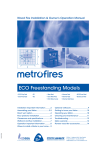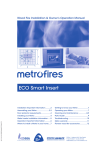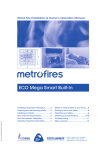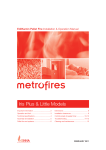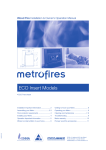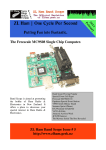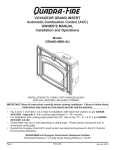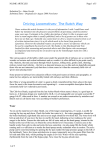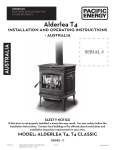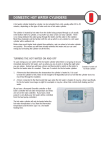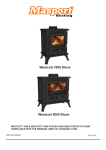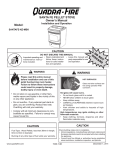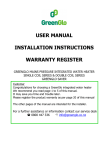Download metrofires Ambie Plus Installation manual
Transcript
Wood Fire Installation Manual Ambience Series • Ambie One • Ambie Plus *Refer to the other side of this manual for Metro owners operation and warranty details PO Box 11, Inglewood 4347, New Zealand Ph (06) 756 6520 • Fax (06) 756 6540 [email protected] • www.metrofires.co.nz WARNING! Important Information • WE RECOMMEND YOU READ THIS ENTIRE MANUAL. BUT IF YOU DON’T, YOU MUST READ PAGE A & PAGE 1 • The appliance and flue-system shall be installed in accordance with AS/NZS 2918 and the appropriate requirements of the relevant building code or codes • Any modification of the appliance that has not been approved in writing by the testing authority is considered to be in breach of the approval granted for compliance with AS/NZS 4013 CAUTION! Important Information • Mixing of appliance or flue-system components from different sources or modifying the dimensional specification or components may result in hazardous conditions. Where such action is • This Metro wood fire has been tested to and complies with AS/ NZS2918:2001 when installed in accordance with this manual. Please ensure you are fully conversant with this relevant standard and the contents of this manual. Correct installation is critical to the safe operation and performance of this wood fire. • All flue pipe joints must be sealed and riveted. The bottom of the flue pipe in particular MUST be fully sealed into the flue outlet of the Metro wood fire. • In New Zealand, the Metro must be bolted through the floor protector into the floor to comply with the seismic restraint provisions of AS/NZS2918:2001 • All Metro’s are extremely heavy, varying in weight from 85kgs up to 150kgs. During the installation process do not lift the appliance by yourself, and take care not to damage the panel coating or your floor protector. Please take particular note of the following: • It is recommended that Metro’s be installed with a Metro ECO flue system which has been developed to enhance the performance of Metro wood fires. Any alternative flue system must have a minimum flue pipe length of 4.2 metres of 150mm diameter flue pipe. • The 150mm active flue pipe must be fully encased from the ceiling to the underside of the flashing cone at the top of the flue system, (i.e. there must not be any 150mm flue pipe exposed). page A considered, the manufacturer should be consulted in the first instance. Do not install this Metro if there is any sign of visible damage Assembling your Metro wood fire Metro Ambience Series Diagram 1 To minimise freight damage, the pedestal has not been attached but is packaged inside and against the firebox in two pieces. Some assembly is required as illustrated in Diagram 1 (right). Open the door of the Metro and remove the following: - The pedestal packed in cardboard (Note baffle lift instruction) - The base mounting plate (packed outside firebox up against door) - Side bricks in a cardboard wrapper - Door handle and fastenings pack. 1. Remove the two securing bolts from the base of the firebox which secures the Metro to the wooden pallet. 2. Remove the door by lifting up off the top hinge & lowering off the bottom hinge. Aside with inside of door frame face down. Note: Take care this glass door is very heavy. 3. Remove the “cook top” grille and lay the collapsed Metro carton on the floor behind the Metro. Place one hand into and securely grip the flue outlet, place your other hand under the front of the pallet base and gently tip the Metro backwards until it is resting on its back. 4. Before bolting the pedestal to the base it can be time saving to use the base plate to mark the seismic bolt holes in the floor protector. Refer the clearance chart for specific dimensions. We have provided a hole (x) in the base plate which is the flue centre, so after transferring the flue centre from the ceiling onto the floor using a plumb bob or laser, place the base plate over and align it with the centre mark, orient the plate so it is parallel with wall [45 degrees for corner install] and the correct distances from walls to flue centre using the chart below, you can now scribe the 2 holes to be drilled. Remove the plate and with a diamond tipped drill bit or other suitable tool so as not to break the ceramic tiles carefully drill through the floor protector and into the concrete or wooden floor below. Take the 4x M6 x 10mm socket screws from the bolt bag then fit base plate to the pedestal and secure. ‘X’ ambie one = 1 piece ambie plus = 2 piece FRONT Baffle Diagram 2 Top Baffle 5. Position the pedestal with its front facing up over the four bolts and fit the nuts and washers supplied. Check to ensure the base is correctly aligned and securely tighten the nuts. Gripping the flue outlet once more, gently raise the Metro until it is upright. 6. Install the relevant Ambience appliance. 7. Once your Metro is installed, carefully refit the door and top grille. 8. Open the door fully and fit the side bricks to each side of the fire box. Location lugs are fitted to the base and rear of the firebox to retain the side bricks in position. Refer to Diagram 2. SIDE BRICK page b Floor protector size, construction & fitting - The upper surface of the floor protector must be made of non combustible material. Pioneer manufacture an extensive range of what Pioneer term “Ash Floor Protectors” which comply with the minimum floor protector requirement of AS/NZS2918:2001, and can be installed with any freestanding Metro wood fire. • A suitable floor protector for a Metro freestanding wood fire is therefore any non-combustible material which could include; Metro freestanding wood fires DO NOT require an insulated floor protector as they comply with the minimum floor protector requirements of AS/NZS2918:2001. These minimum floor protector requirements are; - Ceramic tiles with grouted joints fixed directly to timber flooring. - A sheet of toughened glass, panel steel etc. laid directly onto a wooden or other combustible floor. • They must be of adequate size to give appropriate wall, rear and front clearances/projections as detailed in the chart illustrated on page E. Note: If being installed onto a concrete or non-combustible floor a floor protector is not required. Note; Fitting the Floor Protector - The floor protector must extend 100mm horizontally to the rear and 200mm horizontally to each side directly below the door opening, and 300mm forward of the door opening. Once the floor protector is constructed and laid in final position, you are ready to locate the position where the Metro will sit on the floor protector. Clearance Chart Measurements listed below are the minimum required, stated in millimetres. Measurements are taken from the following reference points as illustrated: 167mm (PLUS) 150mm (ONE) - From the nearest combustible wall or surface (A, B, D, E, G, H) - From the Metro’s flue centre (A, B, C, D) - From the outermost point of the Metro’s cabinet construction (E, F, G, H) - To the edge of the ash floor protectors non-combustible surface (C, F, I, J, K, L, M) Metro Installation Clearances Minimum clearances shown are in mm, with a Pioneer double flue mounted shield fitted. A B C D E F G H I J K L M Ambie One Model 250 538 589 391 100 275 250 100 839 825 1142 960 427 Ambie Plus 267 685 658 462 125 275 350 100 925 905 1317 1110 506 Metro Specifications Measurements shown are in mm. Model WIDTH DEPTH HEIGHT N O Ambie One 577 464 717 350 540 Ambie Plus 671 550 761 360 550 page C Wetbacks • WARNING! Important Information • Do not connect to an unvented hot water system. • Install in accordance with AS 3500.4.1 Or NZS 4603 and the appropriate requirements of the relevant building code or codes. To fit the Wetback proceed as follows: 1. Remove the rear panel of the Metro by removing the four pozi drive screws. Remove the two pre-punched knockouts from this panel. Wetbacks 2. Two further knockouts will be visible on the inner rear heatshield; remove these also. Once these are removed 6mm nuts will be visible through the knockout holes. If the home is in a classified “clean air zone”, and dependent on requirements/restrictions which may be imposed by your local council, you may or may not be able to install a water heating device. If in doubt consult your local Metro retailer. Only Pioneer’s cast jacket wetback system should be fitted to a Metro; alternative wetbacks will void the Metro’s emission approvals and may seriously affect the performance of the appliance and void the owner’s warranty. 3. Open the Metro’s door and locate two bolts securing the pressed washers which are visible on the left hand side of the firebox for both inlet and outlet connection points. 4. A further three bolt heads will also be visible on the inside rear wall of the firebox; these are threaded into the 6mm thick firebox. Remove all three. Note; Wetback systems are not suitable for use in locations where the water supply has lime content, lime build up inside the coil will eventually block the coil causing the wetback to fail. 5. Using the tube of sealant supplied with the wetback, apply a liberal bead of sealant around both the two connection pipes and also the outer circumference of the wetback which will face the inside rear wall of the firebox. This will completely seal the wetback to the inside rear wall of the fire on installation. The wetback is fitted to the inside rear of the firebox, with the connection pipe heights illustrated and detailed on the previous page E. Please note: • • It is recommended the return pipe has a minimum rise of 1 in 12; performance will reduce as the distance to the storage cylinder increases. Wetback connections for the Tiny models are 92mm left of the flue centre, and all other Metros wetback connections are 140mm left of the flue centre, facing the Metro/wall; the return pipe connection is directly above the inlet connection. 6.Fit the wetback into the firebox and carefully pass the connection pipes through the holes in the rear of the firebox. Securely attach the wetback using the three bolts previously removed from the rear face of the firebox, fitting them through the slots provided in the wetback’s jacket. Reduced height pedestals are available for certain models to reduce wetback connection heights. 7. The wetback is now ready for connection to the storage cylinder by a registered plumber. Flue installation It is recommended that all Metro freestanding wood fires be installed with the energy efficient Metro ECO flue system which comes complete with a detailed installation manual. This installation manual must be presented with your application to gain consent with your local council. A copy of the installation manual can be downloaded from www.metrofires. co.nz, under Flue Systems, or a copy can be obtained from your Metro retailer. Any alternative flue system must comply with and be installed as detailed in AS/NZS 2918:2008, and a copy of the installation manual must also be presented with your application to gain consent with your local council. ECO Flue • Refer “Important Information” on page A. • The flue systems 150mm diameter flue pipe must terminate a minimum of 4.6 metres above the top surface of the floor protector. System Insta llation Man ual Pioneer Flueshield All Metro’s have been tested with a Pioneer Double Flue Mounted Shield. For the Metro to be installed with minimal clearances as the Clearance Chart states, ONLY the Pioneer Double Mounted Flue Shield can be used. All other flue shields will invalidate the installation. ECO Flue Systems Freestanding Flue System ECO Flue s System Installa tion Options ECO Base ............ 2 Flue System & ECO Option ECO Base Flue System Kits.... 3 Kit Installa ECO Option tion ........ Kit Installa 4-5 tion................ ............. 5 Insert Flue Systems ECO Insert Flue System Kit Installa ECO Flue tion ....... System Minimu 6-7 m Heights .............. 8 The Metro can be installed without a flue shield, if this is the case it needs to be installed as AS/NZS2918:2001 stipulates. All Metro’s require a 150mm diameter flue. Please note: • All joints in the flue pipe must be sealed with Pioneer fire cement (or similar) and riveted. • The base of the flue pipe must be sealed into the outlet of the Metro’s flue stub. This is critical for optimum operation. page D Wood Fire Owner’s Operation and Warranty Manual Ambience Series Important information..................................... 1 Cleaning and maintenance ......................... 3-4 Where to install a Metro in your home............. 2 Troubleshooting.............................................. 5 Optional wetbacks.......................................... 2 Metro warranty............................................... 6 Getting to know your Metro............................ 2 Pioneer wood fire accessories........................ 8 Operating your Metro..................................... 3 GADGET7128 09/11 *Refer to the other side of this manual for Metro installation details PO Box 11, Inglewood 4347, New Zealand Ph (06) 756 6520 • Fax (06) 756 6540 [email protected] • www.metrofires.co.nz WARNING! Important Information • WE RECOMMEND YOU READ THIS ENTIRE MANUAL. BUT IF YOU DON’T, YOU MUST READ PAGE 1 & PAGE A • Never operate your Metro with the door ajar, except on initial start up • Any modification of the appliance that has not been approved in writing by the testing authority is considered as breaching AS/NZS 4013 • Do not store fuel within the Metro’s specified installation clearances • Do not use flammable liquids or aerosols in the vicinity of this appliance when it is operating • Do not use flammable liquids or aerosols to start or rekindle the fire • Do not dry clothes on or near this appliance • Open the air control before opening the Metro’s door • Never operate your Metro Ped or Trad with the cook top grill removed CAUTION! Important Information • This appliance should be maintained & operated at all times in accordance with this instruction manual • This appliance should not be operated with a cracked glass or faulty/missing door seal • Do not use driftwood, treated or unseasoned (wet) fuel, the use of most types of preservative treated wood as fuel can be hazardous • Do not empty ash into a combustible container Congratulations on the purchase of your Metro wood fire • This low-emission, slow combustion appliance is designed to give you many years of warmth and service, subject to five critical factors. These five factors, if not adhered to are the major causes of unsafe installation, poor performance and flue blockages and failure. • 1. Your Metro wood fire must be installed correctly, by a competent or suitably qualified installer. As correct installation is critical to the performance and safe operation of your Metro, it is recommended your Metro be installed by a registered installer or a person suitably qualified in the installation of wood fires. Your Metro retailer will be able to arrange professional installation for you. • 2. The only fuel to be used in this appliance shall be wood that meets the following criteria. – Less than 25% moisture, – Has not been treated with preservatives or impregnated with chemicals or adhesives, – Is not chipboard, particle board, MDF or laminated board, and – Is not painted, stained or oiled Note: Softwood usually takes 12 months to season - Hardwood can take up to 24 months to season - Wood must be stored in a location that enables free air circulation. Wet wood stored in a closed woodshed without air circulation will still be wet 12 months later. • All freestanding Metro’s covered by this manual make ideal cooking appliances. • It is critical that the fire not be operated with faulty or missing door seals, faulty or missing promet extension (white board on the baffle plate) cracked or broken door glass. These three areas require regular inspection/maintenance and if not maintained will void the firebox warranty. •For optimum performance fuel must be loaded so the logs lay “front to rear” in preference to laying across the width of the firebox. Spaces should be left between the logs to enable oxygen to get to as much of the surface of the fuel as possible. • A small hot fire loaded frequently is more efficient than a large fire burning on a low setting. • Your Metro is covered by a full unconditional 12 month warranty on replacement parts, and a 10 year firebox warranty. See page 6 for warranty conditions. 3. The appliance shall be operated at all times in accordance with the “Installation and Operating Instructions” supplied. 4. There shall be no heat re-circulating fan fitted to the appliance 5. In some clean air zones (Urban Canterbury) Metro ECO wood fires can only be installed with a Metro ECO Flue System, as fitting any other flue system will void the ECO Metro’s approvals to AS/NZS4013:1999. If in doubt consult your Metro retailer. Please note the following important points: • In New Zealand a building consent is required from your local building authority; the homeowner is responsible for obtaining this consent. During the very first fire your Metro will give off an odour and fumes as the firebox paint cures. Do not be alarmed; open all windows and externally opening doors in that room and close any internally opening doors. This curing process will last for approximately one hour and is likely to happen this one time. Properly seasoned (dry) timber is necessary for your Metro to operate efficiently; firewood that contains a high moisture content will result in flue pipe blockages and reduce the heat output. This manual is in two sections, with the installation section detailed at the rear of this booklet. Keep this instruction manual for future reference. page 1 Where to install a Metro wood fire in your home and you need to ensure no structural beams or internal gutters etc are directly above your preferred site. If you have a two storey dwelling you need to consider the second storey to ensure you don’t have the flue directly outside a second storey window. Wood fires are usually installed in the main living area, which is the section of the home that is usually kept the warmest, being the area in the home most frequently occupied. However, before deciding on the best location for your Metro wood fire you may wish to consider: • Water heating. If you are intending to have a wetback it is important that the wood fire is as close as practically possible to the water storage cylinder. • Split level homes are best heated when the wood fire is installed on the lower level, as the heated air will rise to the higher levels. • Building construction is another consideration. Specified clearances from walls, curtains etc must be maintained Generally, you can install your Metro in your home anywhere that suits you; Pioneer offer various fan systems to transfer heat to sections of the home that are not heated sufficiently. It is necessary if using a fan system that the Metro you have purchased has sufficient output to heat the total area you wish to heat. Your Metro retailer or installer will be able to advise if you are uncertain. Optional wetbacks If your home is in a classified “clean air zone”, and dependent on requirements/restrictions which may be imposed by your local territorial authority (council) you may or may not be able to install a water heating device. If in doubt consult your local Metro retailer. Water heating is another key feature of your Metro wood fire, and on offer are a number of options depending on the model you have purchased. Metro offer a 2kW wetback suitable for the Tiny Rad and Tiny Ped. All other ECO Metro’s can be fitted with the ECO wetback. Note: Wetbacks are not suitable for use in locations where the water supply has lime content. Lime build up inside the coil will eventually block the coil causing the wetback to fail. Other considerations are: • Distance from your Metro to the storage cylinder will affect the amount of hot water produced. Cost Savings Wetbacks can enable substantial power savings, dependent on the climate in the area in which you live. If you live in a cold climate you are likely to use your Metro for many months of the year, in which case a Pioneer wetback will reduce or even eliminate your water heating costs over those months. If however you live in a warmer climate and use your Metro for only a few hours a day over the colder months, electricity savings will be considerably less. Water Pressure A common misconception is that you must have a low-pressure system to have a wetback; this is not true. You must have a “vented” system and high-pressure cylinders are usually not vented. However you can install an “indirect” cylinder which contains a secondary coil inside the storage cylinder, enabling you to have a wetback while retaining a high-pressure system. • Your climate & the manner in which you will ‘fire’ your Metro. Getting to know your Metro wood fire Operating your Metro wood fire is simple and you will quickly learn how to get the best from it. First take a minute to familiarise yourself with your new Metro. • Lift the door handle towards you until the latch releases, then slowly pull the door open. • There is a single air control making your Metro easy to adjust. This control moves from left to right, which is “low to high”. Simply pull out to increase burn rate or push in to reduce burn rate. This is a pre-set “low” position. Your Metro must not be operated at a lower burn rate than this pre-set low allows. AMBIE SERIES AIR CONTROL page 2 Operating your Metro wood fire the air control to the right, burn rate, firebox temperature and heat output will increase, if you move the control to the left they will decrease. Note: If your Metro has only been installed within the past few days, the fire cement seal at the base of the flue will not be fully cured. To ensure the cement sets without blistering it is recommended you burn 2-3 sheets of loosely crumpled newspaper at a time, approximately once every hour over a 6-8 hour period. During the very first fire your Metro will give off an odour and fumes as the firebox paint cures. Do not be alarmed. Open all windows and externally opening doors in that room and close any internally opening doors. This curing process will last for approximately one hour and is likely to happen this one time. Start up Place a quantity of loosely crumpled newspaper on the base of the firebox until it is approximately 50% full of paper, or place firelighters on the base of the firebox. Add dry kindling and move the air control knob fully to the right, being the “full open” position. • Always open the air control fully prior to opening the door, then open the door slowly. • When loading logs, place them end-on, “front to back”; air spaces should be left between the logs to enable oxygen to get to as much of the surface of the fuel as possible. • Every time you refuel, leave the air control on “high” for a minimum of 20-25 minutes. • Never use the door to force wood into the firebox, as this is likely to break the glass. Cooking All Metro’s are designed to enable cooking of soups, stews and casseroles etc, and your Metro will easily boil a flat bottom stainless steel kettle. The Radiant Series have a dedicated cooking top enabling large pots to be placed on the cook top, while all other models have a lift-off grille. Light the paper at two or three locations across the front of the door opening and leave the door slightly ajar resting on the latch pin if necessary for a few minutes while the fire establishes. Once the kindling is burning well, open the door and add 2-3 small logs at a time until you have a well-established fire. Usually this will take approximately 30 minutes, during which time the air control should be set on “high” and the door should be closed, except for the initial few minutes and when fuel is being added. Note: Metro’s supplied with a lift-off top grille have this feature to enable the grille to be removed for cleaning if you have a spill. The lift-off top grille must be left on when cooking, because if removed the wall temperatures next to the appliance may become excessive and the top of the firebox is generally too hot to cook on directly. Please note: Although very durable, Metro’s in a satin stainless look are not recommended to be used to cook on. Normal operation Once the fire is well established, regulate the air control to achieve the desired burn rate and heat output. As you move Cleaning and maintenance for your Metro wood fire The Ambience Series wood fires outer panels are coated with vitreous enamel. • Vitreous enamel is extremely durable and designed to last the life of the appliance. As vitreous enamel is glass, a solid or heavy object dropped or banged against a panel could chip the enamel surface. All model Metro’s can be cleaned with a damp cloth when the appliance is not operating. Door glass Providing your fuel is properly seasoned, under normal operating conditions the air-wash design of the Metro’s firebox will keep the door glass clear. If the glass requires cleaning you may use a glass cleaner. If your door glass breaks it must be replaced with 5mm thick ceramic glass which is available from your local Metro retailer. Refer specific glass replacement instruction below. Door glass replacement 1. Take the door off your Metro. 2. Remove the 4 cap screws protruding through the back of the door frame. 3. Release the 6 [8 for Ambie Plus] tensioning screws by turning CLOCKWISE, these are accessible through holes in the back of the door frame, Take care not to screw these in any further than necessary which is flush with the cast hinge boss as you run the risk of the screw busting out the back and breaking the glass. 4. Unbolt and remove the bottom section of the door frame. 5. Remove the 6mm nut securing the latch to the spindle, gently tap the latch plate until it comes loose on the spindle, remove the plate and extract the door handle spindle from the frame. 6. You can now extract the cast backing plate from the door frame, take care not to drop the casting as it will break. 7. The glass can now be removed out the same opening. 8. Replacement is the reverse of the above procedure with the following notes. 9.Fully tighten the 4 removable section securing screws before attempting to tension the glass in the frame. 10.Fit the 4 long locating screws leaving them protruding by approx 4mm, this correctly locates the casting inside the frame. page 3 Cleaning and maintenance for your Metro wood fire 11. Now start tensioning the frame to the glass by gently turning the adjusting screws COUNTERCLOCKWISE working your way diagonally around the 6 screws [8 for Ambie Plus]. Do not over tighten. 12. You will need to go around 2 or 3 times as the glass tape compresses, take care not to over tighten as you will bend the frame edges. An approximate force of 5 to 10Kg on the end of the Allen key is enough. 13. Now retighten the 4 external locating screws and refit the latch assembly. • Open the door, and using a hearth shovel or similar, empty the excess ash directly into a steel or non-combustible container. • If the ash is not disposed of immediately, be careful where you store it, as the ash can retain heat for many days and become a fire hazard. • You must leave a bed of ash in the base of the firebox approximately 10mm deep; this insulates the base of the firebox and improves combustion. Top baffle Door seals This is a ‘sacrificial’ part of the firebox and should be checked monthly. Usually only the “Promet” (white board) section needs to be replaced when it starts to disintegrate. Over time, usually 3-4 years, the door and glass seals will become hard and cause air to leak into the firebox, reducing burn time. At this point they require replacing. Your Metro retailer stocks replacement woven fibreglass door and glass seals, and if required will fit these for you. Note: Cracks in the promet are not uncommon and have no adverse effect on the operation of your Metro. These cracks are the result of intense heat coupled with expansion and contraction. The door of your Metro is easily removed, but take care as it is heavy. Hold it in both hands and lift the hinge end of the door up and over the top hinge pin, then lower the door from the bottom hinge pin. Note: Burning wood which is not properly seasoned, i.e. to 25% moisture content or more, will expedite this disintegration. Flue systems Side bricks Should be checked annually, particularly the bottom end of the lower flue section at its rear lock formed joint. If deterioration is noticed contact your Metro retailer or installer. Hair-line cracks are not uncommon and are a result of the intense heat within the Metro’s firebox, coupled with mechanical damage caused by accidental impact when fuel is being loaded. However if the side bricks become cracked to the extent that they start to break up, they must be replaced. The flue pipe should also be swept a minimum of once a year, or as required during the winter season. If smoke enters the room when you open the Metro’s door this usually indicates the flue pipe is becoming restricted and needs cleaning. The frequency of flue pipe cleans depends on many factors, with the main variables being: Door adjustment From time to time as the door rope and glass tapes compress it becomes necessary to adjust the door. There are 2 areas that can be adjusted 1. Door latch pin, using a 6mm hex key hold the cap screw and loosen the nut inside the firebox, gently tap the latch pin assembly to the rear of the fire a couple of millimeters, retighten and try the door, repeat if required, make sure the roller is still free to rotate. Be sure not to set the pin too far back as this latch design requires very little force from the user to obtain a good seal, it should be just firm at the final latching movement. • The seasoning of the wood. If not properly seasoned you will require frequent flue pipe cleans. • The density of the wood. Softwoods generally result in more creosote build-up in the flue pipe. Pioneer produce a telescopic fluebrush system which is available from your Metro retailer. To clean the flue pipe of your Metro, proceed as follows:- 2. Door hinge, as you close the door you should feel the door rope should start to contact the firebox lip when the door latch is about 30mm away from the latch pin, if it doesn’t or you can see a gap looking down between the rope and the firebox at the hinge end when the door is closed, open the door and loosen the top hinge bolt and screw the top jacking screw clockwise 1 full turn, nip the bolt up then loosen the bottom retaining bolt and unscrew counterclockwise the bottom jacking screw 1 full turn while pushing down on the opened door this will force the hinge to rotate around the top bolt until the bottom jack screw bears against the jacking plate, retighten both bolts and close the door, repeat if required. Ash removal Over a period of time ash will build up in the base of the Metro’s firebox and require removal. The time this build-up takes depends on the density and cleanliness of your fuel. To remove the excess ash your Metro should not be operating. • Open the Metro’s door fully, reach inside with the palm of your hand face-up and extended, lift the top baffle approximately 20mm, then lift it forward out through the door opening, placing it on a sheet of newspaper you have placed on the front of the floor protector. • Close the door and slide the air control to the left. • Once on the roof, remove the cowl from the top of flue system and sweep the flue pipe using a 150mm-diameter flue pipe brush as detailed in the instructions provided with the fluebrush. • Once the flue pipe is clear, clean and refit the cowl. Remove the excess soot which has fallen into the firebox, leaving a layer of ash 10mm deep on the base of the firebox, then refit the top baffle. Note: the baffle must be fitted so its rear is touching the back of the firebox; if uncertain refer to page B in the installation section at the rear of this manual, which shows illustrations of the baffle location. page 4 Troubleshooting your Metro wood fire If your Metro didn’t smoke, but its starting too and is getting worse: If your Metro is installed correctly, your fuel is dry and you operate it correctly you will find it to be a pleasure to use. Metro’s many years of experience within the wood heating industry has shown that 99% of customer dissatisfaction is due to: • • • The flue pipe is in need of a clean. It is recommended that the flue pipe to be cleaned every season, however if you are burning the fire on low a lot, or are using unseasoned fuel, flue pipe cleans will be required more frequently. unseasoned fuel faulty installation operational error or a combination of the above 3 points Correct operation: The following may be of assistance if you are experiencing any of these problems. SMOKE ENTERS THE ROOM WHEN THE METRO’S DOOR IS AJAR: (POSSIBLE REASONS AND SOLUTIONS) Check flue pipe joints: If the flue pipe joins are not sealed correctly, smoke will not draft up the flue pipe near as well. The flue pipe join connecting into the flue spigot on top of the Metro is most critical, if this is not sealed correctly, smoke will enter the room when the door is ajar. To check this join is correctly sealed correctly, run a match or lighter flame around the join, if the flame is sucked into the spigot, then it’s not sealed. This check needs to be done when the fire is not going, be sure to check the rear of the join as that is where the biggest gap is, due to the seam in the flue pipe, which is always on the rear of the flue pipe. Ensure the fuel you are using is correctly seasoned: If you are burning unseasoned fuel (wet), the fire will cause nothing but problems. The Metro won’t deliver much heat, it will be lazy, it will smoke into the room when the door is ajar, and the door glass will run black. Flue pipe length is too short: Add more flue pipe as the longer the flue system, better the draft of smoke up the flue pipe. Please note, if you did not purchase the Metro ECO Flue System, you will not have the ECO Cowl which increases draft. We highly recommend the Metro ECO Cowl is fitted, this will increase the draft, if you already have an ECO Cowl and smoke is still entering the room, add another 600mm length of flue pipe. Downdraft: OTHER ISSUES THAT YOU MAY EXPERIENCE I can smell smoke in the room after a low burn cycle The smell is creosote that will be seeping through the flue pipe joints or out of the flue spigot onto an external surface, thus creating the smell in your room. The cause will be either unseasoned fuel or incorrect operation on low burn cycles. Creosote is very corrosive and excessive buildups will result in the flue pipe and potentially the flue spigot and upper burn chamber failing. Failure of flue pipe or firebox due to creosote build up is not covered under warranty as creosote build up is only possible from either unseasoned fuel or incorrect operation. The Metro is noisy as it heats up and cools down There will always be some expansion and contraction noise as the Metro heats and cools, however this can be usually reduced substantially by loosening three nuts at the rear of the appliance. To remedy, locate the 25mm deep cavity at the rear of your Metro between the “rear panel” and the “inner rear heat shield”, so you will see a 6mm nut and two 6mm bolt heads in this cavity. Using a 10mm ring or open ended spanner, loosen all three so they are finger tight only. The Metro won’t turn down as much as it did The door itself may need readjusting, the hinge and latch is slotted and allows for movement, loosen the hinge and move back a few mm, this will make the door seal tighter which will stop air leaking into the fire. The door and glass seals may be in need of replacing, which is generally needed every 3-4 years. If you have checked all of the above and the fire is still smoking into the room, it’s possible there may be a down draft issue. Down draft is something that is not fixed with a single fix, it’s purely trial and error, things to try: - Familiarise yourself with the instructions on page 4 before proceeding with this maintenance. - “H” Cowl, designed purely for downdraft issues, but if you have an ECO Cowl fitted as standard, you will also need to add another 600mm of flue pipe to compensate as the H Cowl is shorter in length - Modern day wood fires need to be operated hard and fast, more so than low and lazy to ensure the firebox and flue pipe runs hot and efficient. If the fire and flue pipe is up to temperature it will perform extremely well, the smoke will draw up the flue pipe with ease, and the fire will produce good amounts of heat, if the fire is operated on low a lot of the time, the door glass will run black, the flue pipe will tend block up more frequent, and the fire will end up smoking into the room when reloading. It’s better to have a small fire running hard and fast, rather than a big fire running low and lazy. Directional Cowl, designed for high wind areas Air control setting: ensure the air control setting is on high before opening the door to reload, this will increase the draft of smoke up the flue pipe. page 5 Warranty details for your Metro wood fire • Operation of this appliance in violation of the warnings in the operation and installation manual will void this warranty. Metro wood fires are manufactured in New Zealand, using the highest quality of materials, workmanship and the latest manufacturing techniques, which is why we offer a full 10 year firebox warranty and 1 year parts warranty for peace of mind. • Failure to do the necessary inspection & maintenance of this appliance in accordance with the instructions in the operation manual will void this warranty. It is critical that the fire not be operated with faulty or missing door seals, faulty or missing top baffle including the promet extension (front white board on the baffle plate) cracked or broken door glass. These areas require regular inspection/maintenance and if not maintained will void the firebox warranty. Metro Warranty (NZ Consumer laws apply to this warranty) Pioneer Manufacturing Limited (Pioneer) warrants the steel firebox against defective materials and workmanship which would render it unfit for normal domestic use, from the date of purchase by the original consumer, for a period of 10 years. • A claim under this warranty should be directed to the retailer who supplied the Metro wood fire. If this is not possible write direct to the manufacturer stating details of fault, serial number of your Metro, date and proof of purchase and name of retailer where the Metro was purchased. Components including panel coating, door retainers, door seals, glass, trim, baffle & bricks are warranted for a period of 1 year from the date of original purchase for domestic use against defective materials and workmanship. Warranty Exclusions: This manufacturer’s warranty does not cover: • All associated accessories including, but not limited to, fans, flue systems, flue shields, wetbacks, tool sets, ash pots etc, are covered by a 1 year warranty against defective materials and workmanship. • Defects caused by factors other than normal domestic use or use in accordance with the product’s operation manual. It is recommended, but not a condition of this warranty, that a full service/inspection of the Metro wood fire be carried out at the end of each winter season. • Defects caused through the product being operated in an “over-fired” manner resulting in sections of the firebox operating excessively hot to the point that sections glow red. (Note – This will result in distortion of the firebox) Warranty Conditions: • Defects to the product caused by accident, neglect, misuse or act of God. • The Metro wood fire must be installed, operated and maintained strictly in accordance with the building code and the manufacturer’s installation and operation manuals. • • The cost of repairs carried out by non-authorised repairers or the cost of correcting such unauthorised repairs. The Metro wood fire must be installed and used in a domestic application. • This warranty covers appliance like for like replacement or repair at the manufacturer’s discretion but excludes freight, travel, installation and/or any other associated costs. • Pioneer or their agents are not liable for any loss or expense direct or indirect arising from the failure of any part or operation of the appliance. Service calls which are not related to any defect in the product (i.e. operational, installation or fuel issues). The cost of a service call will be charged if the problem is not found to be a product fault. • Normal recommended maintenance as set out in the Product’s Owners Operation Manual. Service under this manufacturer’s warranty must be provided by a repairer authorised by Pioneer Manufacturing Ltd. Such service shall be provided during normal business hours. Mamaku Street, Inglewood 4330, New Zealand PO Box 11, Inglewood 4347, New Zealand Ph (06) 756 6520 • Fax (06) 756 6540 [email protected] • www.metrofires.co.nz IMPORTANT! Complete and retain these details at time of purchase: Purchase Date Serial Number Model Colour Retailer page 6












